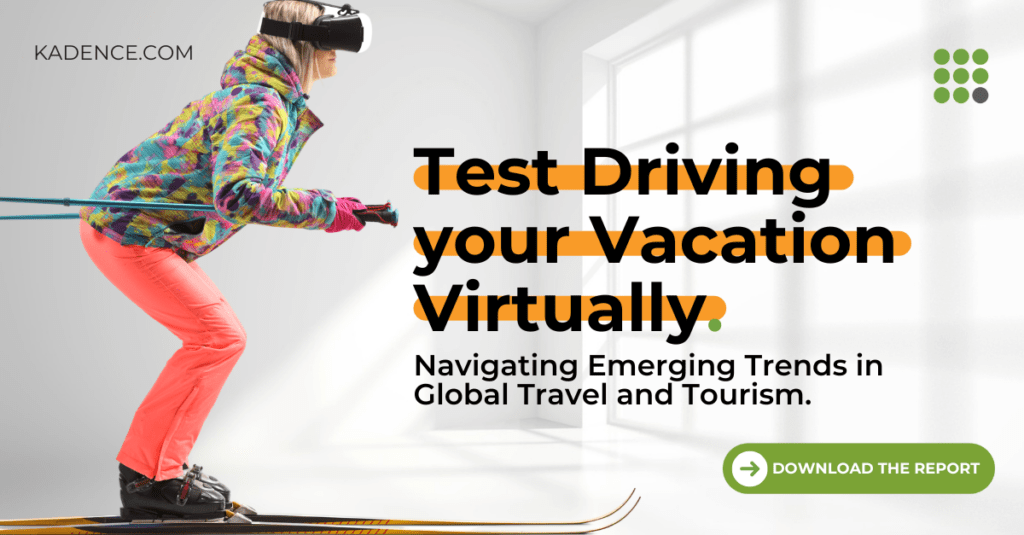Have you ever noticed how quickly food trends come and go? One moment, everyone’s into overnight oats, and then suddenly, coronation chicken makes a comeback, and orzo and vegan cheese are everywhere.
The food and beverage industry must understand its customers’ preferences to keep up with the rapid pace of change. Unlocking the secrets behind consumer desires, understanding the motives driving their choices, and grasping how they view brands can dramatically shift a product from being just another option on the shelf to becoming a beloved market leader. Traditionally, this understanding has been the domain of qualitative research. This methodological approach digs into the complexity of human behaviour and motivation through interviews, focus groups, and observational studies. This method, however, has often been seen as too slow, expensive, or cumbersome for widespread use, especially when compared to the broader strokes of quantitative data analysis.
Enter qual-at-scale, a revolutionary approach that harnesses the power of artificial intelligence (AI) to redefine qualitative research. This innovative method marries the depth and nuance of traditional qualitative techniques with modern technology’s speed, efficiency, and scalability. At its heart, qual-at-Scale utilises AI algorithms to process and analyse large volumes of unstructured data—such as open-ended survey responses, social media conversations, and video feedback—transforming it into actionable insights with unprecedented speed. This democratises access to in-depth consumer insights and enables F&B brands to stay agile, making informed decisions based on a comprehensive market understanding.
AI unlocks a new era of qualitative analysis at scale, giving us rich, detailed narratives behind consumer choices and elevating strategic decision-making to new heights of precision and relevance.
The Value of Qualitative Research in Consumer Insight Gathering
Qualitative research delves into the complex stories behind consumer behaviour, revealing the emotional and psychological reasons behind decisions. Using interviews, focus groups, and ethnographic studies, qualitative research provides a rich, nuanced view of consumer attitudes and behaviours, revealing the “why” behind the “what,” helping brands create more impactful strategies and products tailored to their audience’s needs. The approach of qual-at-scale combines qualitative and quantitative research, utilising AI and human intelligence to provide a fuller understanding of consumer trends. This method allows for larger sample sizes in qualitative research, offering timely and relevant insights to address business challenges effectively.
So, why has consumer research historically favoured quantitative methods over qualitative ones?
Quantitative research has been seen as the faster, cheaper, and more scalable way to gather insights. With statistical analyses and broad sample sizes, it’s no wonder it has been the go-to method for companies looking to gain generalizable insights.
However, many fail to realise that qualitative insights are just as valuable, if not more so, for their ability to provide rich context and depth that numbers alone cannot convey. And that’s where AI comes in.
Qual-at-scale powered by AI is transforming market research, offering brands a dynamic way to tackle challenges and make strategic decisions. With the integration of AI, analysing vast amounts of qualitative data has become manageable and insightful, giving brands a competitive edge by uncovering hidden nuances and epiphanies in consumer behaviour and market trends.
The fusion of human intelligence (HI) and AI creates a co-empowerment — it broadens the scope of research, enabling more iterative approaches and a deeper exploration of data.
Human-in-the-Loop: Guiding AI to Relevant Outcomes
The “human-in-the-loop” concept revolutionises qualitative research at scale by marrying AI’s efficiency with human expertise. This synergy ensures AI-driven insights are not just data-rich but deeply meaningful, as human oversight adds a layer of creativity and critical thinking to the mix. By embracing this approach, we unlock a dynamic fusion of AI precision and human intuition, capturing consumer insights with unparalleled accuracy and adapting swiftly to evolving trends. This model doesn’t just enhance research outcomes; it propels continuous learning and improvement in AI systems, perfectly aligning with the ever-changing landscape of consumer behaviour.
Advantages of qual-at-scale
- Efficiency in Data Analysis: AI-driven analysis of large volumes of qualitative data significantly reduces the time needed to derive insights.
- Cost-Effectiveness: Reduces the financial burden traditionally associated with in-depth qualitative research by automating data processing and analysis.
- Scalability: Allows for examining data from a broader and more diverse set of consumers than would be feasible with traditional methods.
- Depth of Insight: Maintains qualitative research’s rich, nuanced understanding characteristic, even when analysing large datasets.
- Agility in Response: Enables quicker decision-making based on up-to-date consumer insights, allowing brands to adapt to market changes rapidly.
- Bridging Qualitative and Quantitative: Merges the detailed insight of qualitative research with the scalability and broad applicability of quantitative methods.
- Enhanced Accuracy: AI algorithms can uncover patterns and insights that might be overlooked in manual analysis, reducing human error and bias.
- Dynamic Learning: The “human-in-the-loop” approach allows AI systems to improve and adapt, ensuring insights remain relevant continuously.
- Democratisation of Research: Makes detailed consumer insights accessible to companies of all sizes, not just those with substantial research budgets.
- Sentimental analysis and trend detection: From sentiment analysis to trend detection, AI algorithms can identify patterns and insights that might escape even the most experienced human researchers. This capability allows brands to detect and adapt to shifting trends early, staying ahead in their market.
- Iterative Exploration: Supports more flexible and ongoing research approaches, allowing for exploring emerging trends and behaviours as they develop.
AI-enhanced tools transforming qualitative research in F&B
Integrating AI into qualitative research methodologies has significantly augmented the capabilities of researchers, especially within the dynamic food and beverage sector.
Below, we explore several key areas where AI is making a substantial impact.
Discussion Boards.
AI is revolutionising discussion boards, especially in the food and beverage industry. It’s not just about asking the right questions to get deep, insightful answers from consumers anymore. AI steps in to keep conversations relevant by moderating content and even highlights trends like the growing demand for non-alcoholic or low-sugar drinks. This means companies can quickly adapt, crafting products that hit the mark with consumers. It’s a game-changer, making the process more efficient and insightful, without the usual bias.
Focus Groups and In-Depth Interviews
In the dynamic world of the food and beverage industry, qualitative research methods like focus groups and in-depth interviews (IDIs) are key to unlocking consumer attitudes and behaviours.
Now, imagine coupling these time-tested approaches with the power of AI. AI doesn’t just assist in crafting precise discussion guides to draw out rich insights; it transforms the way we analyse feedback.
By swiftly identifying common themes and sentiments, AI ensures that critical insights jump out at us, speeding up the decision-making process. Picture a snack brand leveraging AI to sift through focus group feedback on a new product’s taste and packaging.
The result? A faster track to pinpointing what delights consumers and what needs tweaking.
Video Analysis
Video feedback is revolutionising how we understand consumer reactions, especially with the power of AI. Imagine capturing not just what people say about a new coffee flavour, but how they feel —their excitement, their surprise, all through analysing their expressions and body language. This isn’t just feedback; it’s a window into the genuine, unspoken reactions words alone can’t capture.
Key Strategies for Conducting Effective Mass Qualitative Studies
While the advantages of qual-at-scale research are significant, it’s crucial to recognize that it’s not the universal solution for all research needs.
Selecting the appropriate research methods tailored to specific business objectives is essential. However, the value of this methodology should not be understated, and its potential benefits warrant consideration for its inclusion in research strategies.
In my experience, I have found these guidelines essential for executing a successful qual-at-scale study:
- Simplify your approach: Aim for a broad and straightforward study design. Complexities can complicate the analysis process, requiring more time to filter through the data.
- Avoid overanalyzing: Qual-at-scale differs fundamentally from small-scale qualitative studies. Instead of an in-depth analysis of every detail, aim for a broader overview to capture a wide perspective on the subject matter. Nonetheless, the study’s specific objectives can influence the depth of analysis required.
- Leverage social media for additional insights: Social media platforms offer direct interaction between brands and consumers, making it easier to gather consumer insights through polls, questions, competitions, or organic interactions via social media customer service.
- Maintain contextual balance: Achieving a balance between understanding the overarching context without overlooking the minutiae is crucial. This dual perspective enables researchers to derive accurate and meaningful insights.
- Select appropriate tools for your research: Research projects require specific tools aligned with their goals. Tools can vary from social media engagement for policy changes or branding to dedicated research panels for product development or marketing refinement.
Tools and strategies for effective qual-at-scale research
When launching qual-at-scale research, researchers encounter the challenge of selecting tools that might not be inherently designed for large-scale qualitative analysis. The limitations of traditional qualitative tools and the somewhat restrictive capabilities of survey platforms for handling qualitative data necessitate a thoughtful approach to tool selection.
Here are some of the key elements we consider when undertaking a qual-at-scale study:
- Scalability: The chosen tool must handle a significant volume of data and support automated engagement and analysis to streamline the research process.
- Flexibility: An ideal qual-at-scale tool should capture structured and open-ended data, with a responsive data analysis platform that can adapt to evolving business needs. Setting up strategic pop-up communities for large-scale data capture is valuable, offering insights that can pivot as market dynamics shift.
- Collaboration: Collaboration is vital in iterative research. A skilled team experienced in qual-at-scale can enhance research outcomes by identifying appropriate tools, designing effective programs, and fostering engagement among participants.
Enhancing reporting and storytelling through qual-at-scale
At the heart of qual-at-scale lies the reporting phase, where storytelling meets data. It’s where effective tools shine, blending coding, categorization, and emotional insights to unravel structured data’s secrets. Visualisation helps turn numbers into narratives, making the complex simple and engaging.
Techniques to consider include:
#1. Thematic analysis: This approach is ideally suited for qual-at-scale, allowing for the rapid identification of key themes and nuanced sub-themes. AI technology accelerates the discovery of these patterns, providing a detailed yet efficient analysis.
Let’s say a brand conducts a Thematic Analysis of consumer feedback on a new beverage product. Here are the steps involved:
- Identifying Key Themes: Researchers collect and analyse a large volume of consumer feedback from various sources, such as online forums, social media, and focus group discussions, about a newly launched beverage product.
- Coding and Categorization: The data is then coded for recurring patterns. For example, comments might be categorised into themes such as “flavour preferences,” “packaging appeal,” “health considerations,” and “price sensitivity.”
- Insight Generation: Analysis might reveal that while the new beverage is generally well-received for its unique flavour profile (a positive theme), there are recurring concerns about its high sugar content (a negative theme) and suggestions for more eco-friendly packaging.
- Actionable Recommendations: Based on these themes, the brand could consider developing a low-sugar variant of the beverage and explore sustainable packaging options to address consumer concerns and preferences.
#2. Emotional analysis: By analysing qualitative data at scale, researchers can unlock a deeper empathic understanding, bringing a new dimension to insights to influence decision-making and drive innovation.
For instance, let’s consider a food delivery app that conducts emotional analysis of customer service interactions using AI. This is how the analysis will appear:
- Collecting interaction data: Customer service interactions (emails, chat messages, social media engagements) are gathered from food delivery app users.
- Analysing emotional tone: The data is analysed for emotional content using AI tools capable of detecting sentiments such as frustration, satisfaction, joy, or disappointment.
- Identifying emotional patterns: The analysis might show high frustration related to late deliveries and a sense of satisfaction when customer service responds promptly and empathetically.
- Guiding service improvements: Understanding these emotional responses, the app can implement changes such as improving delivery time estimates and training customer service teams to handle inquiries with even greater empathy and efficiency.
Final Thoughts
As qual-at-scale continues to evolve and integrate more deeply into the research methodologies of F&B, its impact on the industry’s approach to understanding consumer behaviour will be profound. This methodology challenges the traditional dichotomy between quantitative and qualitative research, suggesting a more holistic approach that equally values depth and breadth of insight.
In the future, qual-at-scale could become the standard for consumer insights research, pushing brands to adopt more sophisticated, AI-driven approaches to understanding their customers. This shift toward more nuanced, data-driven strategies is likely to redefine competition in the industry, with success increasingly dependent on a company’s ability to adapt to consumer needs and preferences quickly and effectively.
The promise of qual-at-scale in transforming consumer insights research is immense, offering the food and beverage sector an unparalleled opportunity to deepen its understanding of consumers. By leveraging AI’s power to enhance qualitative research’s scalability and effectiveness, brands can gain the insights needed to innovate and adapt in a rapidly changing market. As this methodology continues to evolve, it will undoubtedly become an essential strategy for any brand looking to gain a competitive edge, reshaping industry approaches to consumer behaviour.




 Senior Marketing Executive
Senior Marketing Executive Sales & Marketing
Sales & Marketing General Manager PR -Internal Communications & Government Affairs
General Manager PR -Internal Communications & Government Affairs Vital Strategies
Vital Strategies
 Customer Intelligence Director
Customer Intelligence Director